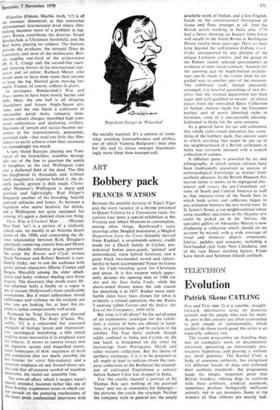ART
Bobbery pack
FRANCIS WATSON
Between the amiable ferocity of Tipu's Tiger and the ivory vacancy of a throne presented to Queen Victoria by a Travancore rajah, the curious may enter a special exhibition at the Victoria and Albert Museum to contemplate, among other things, Rembrandt's sepia drawings after Moghul miniatures, a Moghul Deposition from the Cross distantly derived from Raphael, a seventeenth-century cradle made for a Dutch family in Ceylon, pre- industrial Indian piece-goods, 'painted' and embroidered, more hybrid furniture, and a great black two-handed sword said (uncer- tainly) to have accompanied Vasco da Gama on his Cape-rounding quest for Christians and spices. It is this weapon which appar- ently dictates the opening date of 1500 for Art and the East India Trade, while the above-noted throne seems the sole reason for stretching it to 1857. Rather more intel- ligible dates have been chosen for what is evidently a related operation, the BBC Radio 3 exercise called Europe and the Indies: the Era of the Companies, 1600-1824.
But what is it all about? In the sad absence of an explanatory catalogue for the exhibi- tion, a variety of hints are offered in hand- outs, in a picture-book, and by certain of the exhibits. The 'East India' outlook, though oddly confined to India and Ceylon on the one hand, is broadened on the other by borrowings from Portuguese, Dutch and other western collections. But the theme of aesthetic exchange, if it is to be proposed at all, ought at least to indicate (from the com- pany collections or the Bodleian) the oriental- ism of cultivated Englishmen a century before Robert Clive was shipped to India.
For 'the courtly channel' a portrait of Sir Thomas Roe says nothing of the assorted 'toyes' sent out as sweeteners for Jahangir- the pictures, the coach, the virginals. Neither the company style in general nor the amply
available work of Indian, and a few English, hands on the commissioned illustration of fauna and flora, emerges at all. And the British artists working in India after 1770 had a better showing (as Keeper John Irwin will recall) in the South Room at Burlington House twenty-three years ago. Here we have little beyond the well-known Zoffany Cock- Fight, unsupported by any glimpse of the unique Lucknow context, and the group of the Palmer family selected (presumably) as evidence of inter-racial contacts. Amends for the yawning gap on Anglo-Indian architec- ture can be made if the visitor finds his un- guided way to another part of the museum. The exhibition itself, though pleasantly arranged, is a fanciful garnishing of two dis- plays that the oriental department has been eager and well qualified to mount : of choice pieces from the unrivalled Baker Collection of Indian chintzes made for the European market, and of newly identified styles in furniture, some of it unexpectedly pleasing, fashioned in India for the same purpose.
As a general battu for art and commerce this whole radio-visual enterprise has some- thing of the bobbery pack, that ancient sport in which anything that might be put up in the neighbourhood of a British settlement in India was furiously pursued with a scratch collection of canines.
A different game is provided by art and ethnography, in which certain cultures have been traditionally preserved as sources of anthropological knowledge as distinct from aesthetic pleasure. In the British Museum this section (soon, it seems, to be segregated else- where) still covers the pre-Columbian cul- tures of South and Central America as well as that treasure-trove of the South Seas to which both artists and collectors began to pay attention between the two world wars. In St James's Street, a top neighbourhood where some excellent specimens of the Oceanic arts could be picked up in the 'thirties, the specialist gallery of Alexander Martin is now displaying a collection which should on no account be missed, with a wide coverage of ritual and domestic objects, ornaments, fabrics, paddles and weapons, including a bird-headed club from New Caledonia, one of the rare Maori standing figures, Fijian kava bowls and Solomon Islands artifacts.






















































 Previous page
Previous page